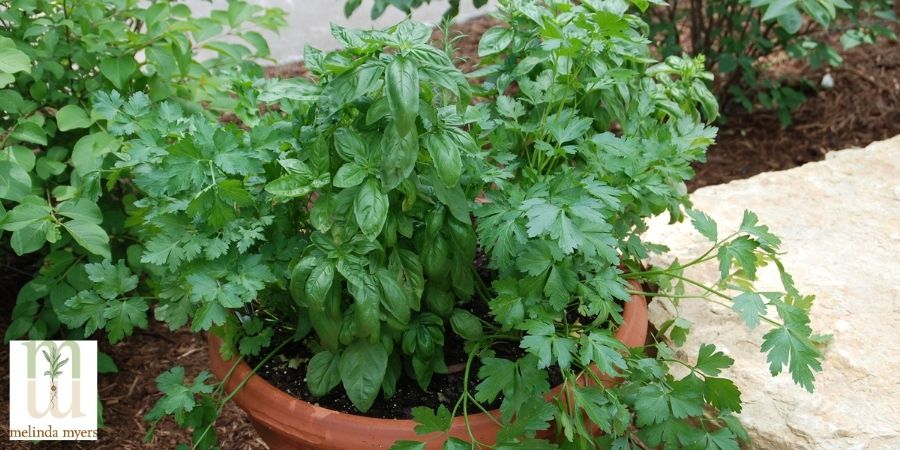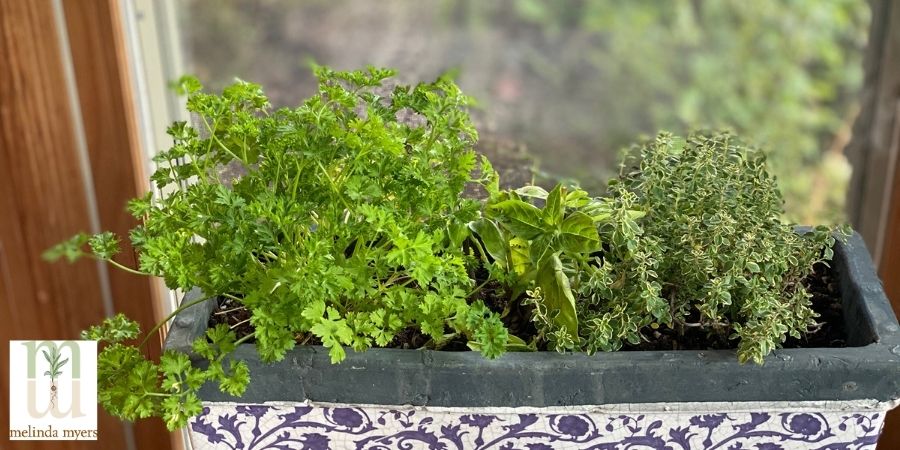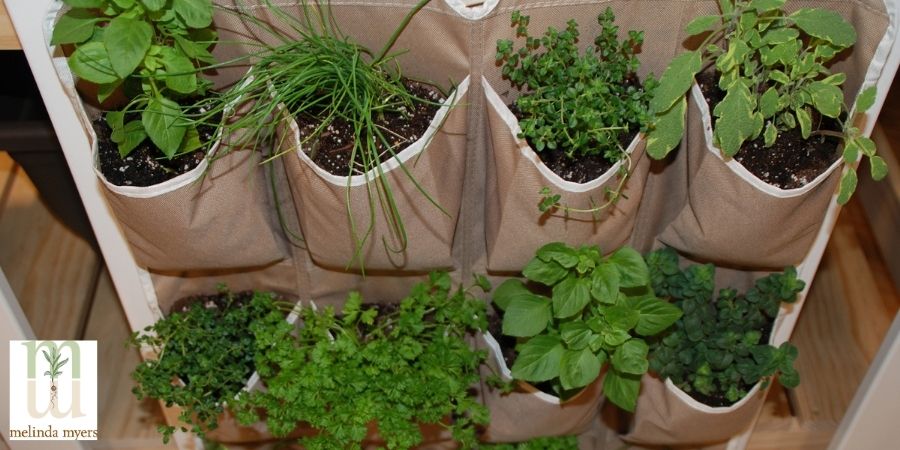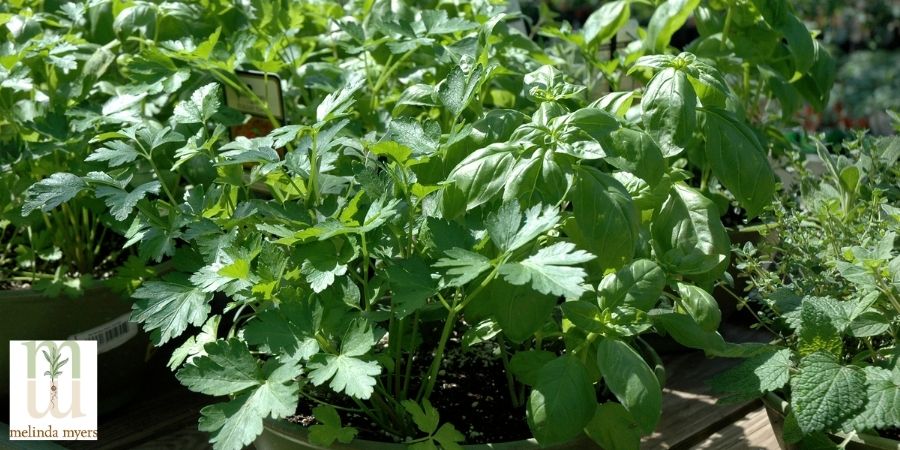Growing Herbs Indoors and Out
- horticulturist and gardening expertFebruary 13, 2021
Add some flavor and fragrance to your garden, meals, and beverages with homegrown herbs. They add unbeatable flavor and nutrition to every dish, making even mediocre cooks, like me, look good.
You don’t need a dedicated garden for growing herbs. Tuck them into your flower, vegetable, and container gardens. Their leaves add subtle color and texture to any garden and their fragrance provides a bit of garden aromatherapy.
Keep the flavor growing year-round and within easy reach with an indoor herb garden. You’ll enjoy fresh herbs, no matter what the weather is like outside.

Growing Herbs Outdoors
Consider growing those herbs you use most or those you prefer to use fresh. Include extras for preserving as well as adding to dried arrangements, potpourris, and other crafts.
Check the plant tags, catalog descriptions, and local University Extension publication for proper spacing, light and soil requirements, and recommended planting dates. Make sure the herbs you select will thrive in your climate and growing conditions.
Most herbs prefer full sun and well-drained soils. Find a sunny location to create an herb garden or when adding them to existing edible and ornamental plantings. Just be sure to avoid chemicals not suitable for edible plants when growing them alongside flowers and shrubs.
As always prepare the soil before planting. Incorporating several inches of compost into the top 8 to 12 inches of soil will improve drainage in clay soils and water retention in sandy soils. Compost also encourages healthy growth that is less susceptible to insect and disease problems.
This is also a good time to add Milorganite. This low nitrogen slow release fertilizer contains 85% organic matter. Milorganite feeds the soil as well as your plants providing nutrients for several months. This means most of us will only need to fertilize at planting and once more mid-summer.
Create a few herb planters for your patio, deck, or balcony. Use a container with drainage holes to prevent waterlogged soils. Unglazed clay pots dry out more quickly while glazed and plastic pots stay moist longer. Self-watering pots have reservoirs you fill extending the time between watering.

Fill the container with a quality well-drained potting mix. I add Milorganite to the potting mix at planting and if needed mid-summer. It eliminates the need to mix and fertilize weekly.
Fill each planter with your favorite herbs or combine them with a few edibles like tomatoes, eggplants, and peppers. Edible flowers like calendula and nasturtiums also make attractive edible partners for herbs. Growing herb-filled containers near the kitchen and outdoor dining spaces make cooking and serving convenient. Allow guest to flavor their favorite beverage or harvest and dress up their own meals for a bit of interactive dining.
Water new plantings thoroughly and often enough to keep the soil slightly moist. Once established most herb plants should be watered thoroughly when the top few inches of soil are crumbly and starting to dry. Check container plantings daily and water thoroughly as needed. Adjust your watering schedule to fit the growing conditions, soil type, and watering recommendation on the plant tag.
Harvesting Herbs
Snip a few leaves or leaf-covered stems whenever you need them for cooking or garnishing a favorite dish. Harvest when the plant has formed buds, but before they open into flowers for the greatest concentration of flavor. This is the perfect time to harvest herbs you plan to preserve. Don’t worry if your plant has started to flower. You can still use the leaves and most have edible flowers.
Adjust the quantity of herbs used to allow for variations in flavor intensity and your family’s preference. In general, you will need 2-3 times more fresh as dried herbs. So if the recipe calls for 1 teaspoon of dried parsley use 2 or 3 teaspoons of fresh parsley leaves.
Use a pair of sharp garden scissors or pruners for faster and easier harvesting. Make your cuts above a set of healthy leaves to keep the plants looking their best. Don’t worry about harming the plant. Regular harvesting encourages new growth and that means more for you to harvest throughout the growing season.
Be sure to leave enough foliage after the harvest to maintain plant growth. You can remove as much as fifty percent of the foliage from established annual herb plants and one third from established perennial plants.
Extend your enjoyment by freezing and drying herbs for later use. Then try your hand at flavoring butter, vinegar, and oils. These add zest to meals and make great gifts.
Growing Herbs Indoors
Don’t let a lack of space or cold winters stop you from growing your favorite herbs year-round. Plant a few herbs in containers and place in a sunny window or under artificial lights.
Most herbs need 6 to 8 hours of bright light each day. A south-facing window in winter is best but an east- or west-facing window may be sufficient. Increase success with artificial lights. Set the timer for 14 to 16 hours a day and keep lights 6 to 12” above the plants.
Start with a quality potting mix and a container with drainage holes or a self-watering pot. Be sure to use a saucer or tray beneath the pot to protect your woodwork or windowsill. Add a vinyl, felt, or cork placemat for another layer of protection.
Purchase plants or seeds from your garden center, favorite garden catalog, or grocery store. Basil, chives, cilantro, oregano, marjoram, mint, parsley, sage, and thyme are some of the easier herbs to grow indoors. Those that like a challenge may want to give Rosemary and lavender a try.
Starting your indoor herb garden with small plants reduces the time from planting to harvest. Unfortunately, it can be challenging to find herb plants in the winter in many parts of the country. Check the produce department in your grocery store as many sell plants as well as fresh leafy sprigs of popular herbs.

Seeds are generally more available and provide the greatest selection. You will need to wait several weeks for the seeds to sprout and even longer for the plants to reach a harvestable size.
Use a variety of plants to create an attractive display in a large container. Combine plants that have the same growing requirements to ensure success.
Or place each herb plant in its own container. A six-inch pot is a good size for when starting with smaller plants. Growing individual plants in their own container allows you to provide the specific watering, care, and transplanting they need.
Water the containers thoroughly whenever the top inch of soil is dry. Pour off excess water so the plant does not sit in water and succumb to root rot. Or place pebbles in the tray to elevate the pot above any excess water. This means less work for you and better-growing conditions for the plant.
Begin harvesting most herbs when they reach 6 to 8 inches in height. As the plant grows you will be able to harvest larger quantities and more often.
A Few Herbs to Grow Indoors and Out
Basil is a favorite in pesto, on pizza, and various sauces and dishes. Wait for the danger of frost to pass and air and soil to warm before planting this annual herb outdoors. Cold temperatures can stunt and weaken the plants increasing the risk of disease.
Many basil varieties are ornamental as well as edible adding color and texture to the garden or container. Purple varieties like Red Rubin, Purple Ruffles, and Dark Opal make a colorful addition to the garden, great for vinegars and garnishes. Use these as you would green leaf basils. Look for downy-mildew resistant varieties like Prospera® Italian large leaf, Prospera® Compact, Rutgers Devotion, and Rutgers Passion if this disease has been a problem in the past. Or mix things up and add unique flavor with cinnamon and lemon basil.
Cilantro and coriander come from the same plant. When we eat the leaves in salads, salsa, and other dishes it’s cilantro. Once it forms seeds that part of the plant is harvested and used as coriander. Dig and harvest the roots at this time to use in recipes calling for Coriander root.
Cilantro is used in rubs, Indian recipes, and more. Cilantro likes it cool. When warm weather arrives it quickly goes to flower and seed. Flowers are edible but the leaves have a bitter flavor when harvested at this time. Extend the life of your cilantro by keeping the soil cool and moist with proper watering and mulch. Try some of the more heat-tolerant varieties like Slow-Bolt for a longer harvest. Allow the plants to reseed or purchase seeds and make several plantings for additional harvests throughout the growing season.
Chives are one of the easiest herbs to grow. The leaves and the flowers are edible providing a mild onion flavor to salads, potatoes, and other dishes. Try the All-America Selections Winner Geisha Garlic Chives for a mild garlic flavor.
This perennial herb prefers full sun and well-drained soil and reseeds readily. Dig and divide overgrown plantings in spring and weed out any unwanted seedlings. Reduce the number of seedlings by removing and using flowers before they form seeds. Or consider growing it in a container to help restrict its growth. But be prepared to remove any unwanted seedlings that sprout in any crack or nearby garden.
Parsley not only freshens your breath but is a good source of vitamin C. Use it in your favorite vegetable recipes, soups, and more. Many who find cilantro’s flavor a bit too intense use parsley instead. This biennial is usually grown as an annual. It often survives the winter, flowers, and dies the second season. The leaves are still edible but often bitter and tough, but the swallowtail caterpillars don’t seem to mind. This is an essential food for this butterfly’s offspring.
Oregano is a hardy vigorous perennial used to season sauces, bread, and vegetables. It makes a nice edible groundcover or edger in the garden and spiller in a container. Contain the aggressive plants or be prepared to do a bit of weeding and thinning to keep this vigorous grower inbounds.
Greek oregano is considered a culinary favorite. Try ‘Humile’ a compact, creeping Greek oregano for containers, small spaces, and groundcovers. Use variegated oregano for its beauty and edibility. Ornamental oregano varieties are even more beautiful and edible but not real tasty.
This along with mint and thyme are favorites of the bees. Adding them to the garden helps attract these important pollinators to your gardens.
Mint is great for flavoring tea, water, cocktails, and desserts. Grow mint in a container on your patio, steps or deck to keep it from taking over the garden. Some gardeners plant this herb in a pot with drainage holes sunk into the ground. Leave the lip of the container exposed several inches. You will slow it down but this aggressive plant can still escape and invade the garden.
Try a variety of flavors beyond the traditional peppermint. Chocolate has a nice chocolate fragrance and minty chocolate flavor perfect for desserts and sweet cocktails. Add a citrus flair to desserts, beverages, and entrees with lemon, lime, and orange mints. Grow Kentucky Colonel if your favorite summer cocktail is a mint julep.

Thyme is used for flavoring stocks, soups, sauces and main dishes. Grow in full sun and well-drained soil for greater winter survival. The plant stems often root along the ground so even if the main plant dies these rooted stems take over. Prune out dead stems after new growth appears in spring.
Include thyme as an ornamental feature in your landscape and containers. Plant some between steppers where its fragrance is release as your feet brush over the leaves. Or add thyme to containers on your patio and deck, give the plants a pet and enjoy the fragrance. Variegated lemon thyme adds welcome color to the garden with its variegated leaves and lemony twist on the traditional thyme flavor.
Sage is a popular seasoning for sauces, poultry dressing, and sausages. Grow this perennial in well-drained soils for good productivity and winter survival.
Tricolor sage has green, cream, and pink leaves that combine nicely with pink and purple annuals and perennials. Golden sage’s grayish-green leaves have yellow edges that help brighten any planting. Use these more decorative cultivars just as you would the plain leaf sage.
Dill is often used to flavor cold soups, fish dishes, pickles, and yogurt-based salad dressings. Fresh dill tends to lose its flavor when cooked so add it at the end when preparing a cooked dish.
The tall airy plant adds a nice texture to any garden and combines nicely with annual and perennial flowers. Try the compact All-America Selections Fernleaf Dill for smaller spaces and containers.
Dill reseeds readily so you will have plenty of seedlings sprouting in next year’s garden. Just remove unwanted plants but be sure to leave plenty for the swallowtail caterpillars that dine on these plants.
Rosemary, like many other herbs, just begs you to give it a pet as you walk by. The fragrance is wonderful and its flavor is popular in fish, chicken and a variety of dishes.
It prefers full sun and is drought tolerant once established. In mild climates, it can be used as an evergreen shrub growing up to 6 feet tall with lovely blue or white flowers. The rest of us grow it like an annual or bring it indoors to try to overwinter the plant. It may take several tries to find the best location and care when growing Rosemary indoors. Place the plant in a cool sunny location and keep the soil slightly moist. Fortunately, it still smells wonderful even after the leaves turn brown.
Lavender adds a bit of elegance and flavor to any meal. Add some to your lemonade or favorite baked goods. Like Rosemary, it is an evergreen shrub in milder climates. Grow lavender in full sun and well-drained soil to increase success and winter survival. Try Hidcote, Munstead, and Phenomenal English lavender if you garden in a colder climate.
Harvest leaves and flowers to add to your favorite dishes and use in crafts and potpourri. Regularly remove faded flowers to keep the plant looking its best and producing more blooms.
Like Rosemary Lavender can be challenging to grow indoors. Select a brightly lit cool location and keep the soil slightly moist. French lavender may prove a bit easier to overwinter than English.
Whether gardening indoors or out try adding a few of your favorite herbs to your gardens and containers. You’ll be able to transform any beverage or meal from good to memorable with the help of fresh herbs.

